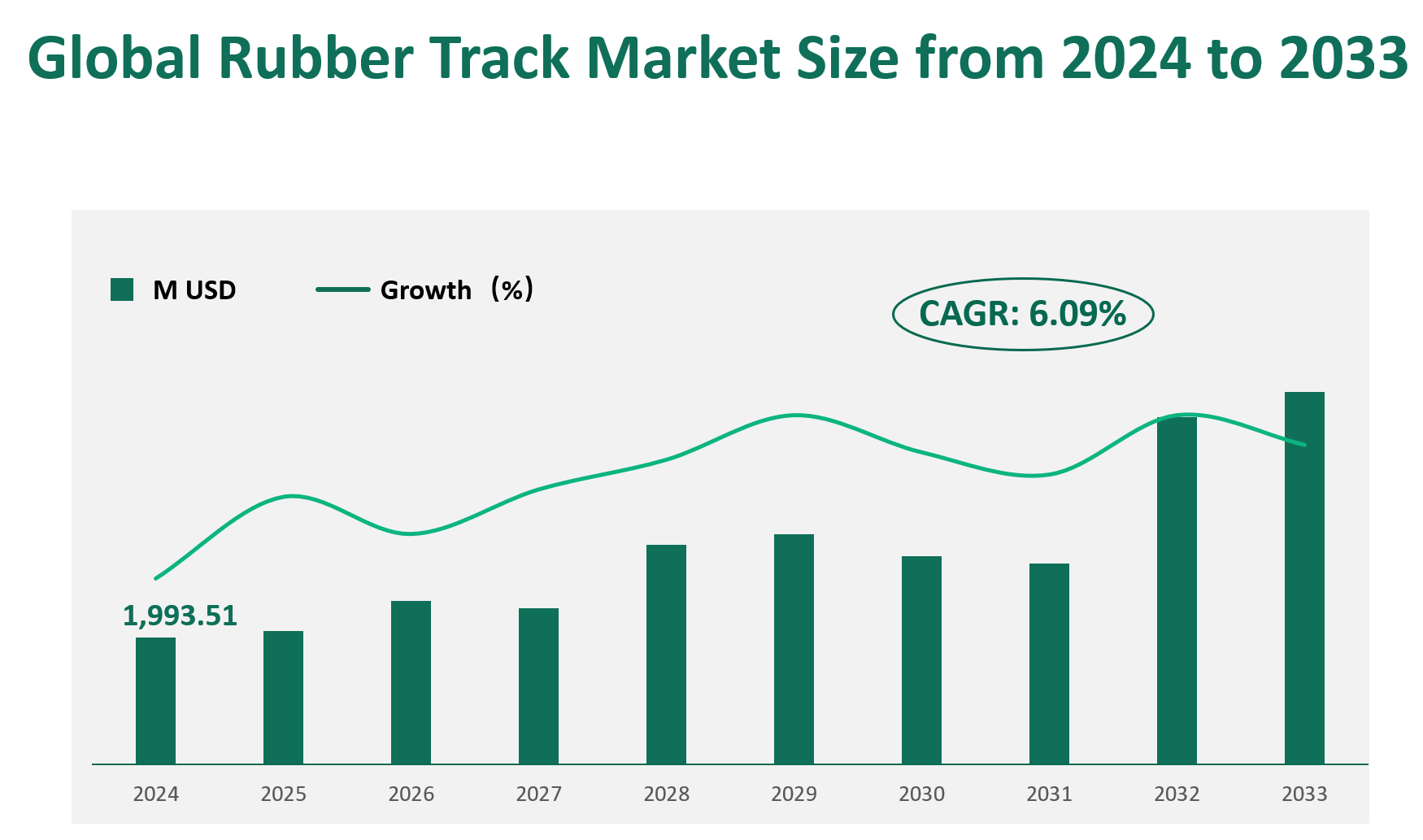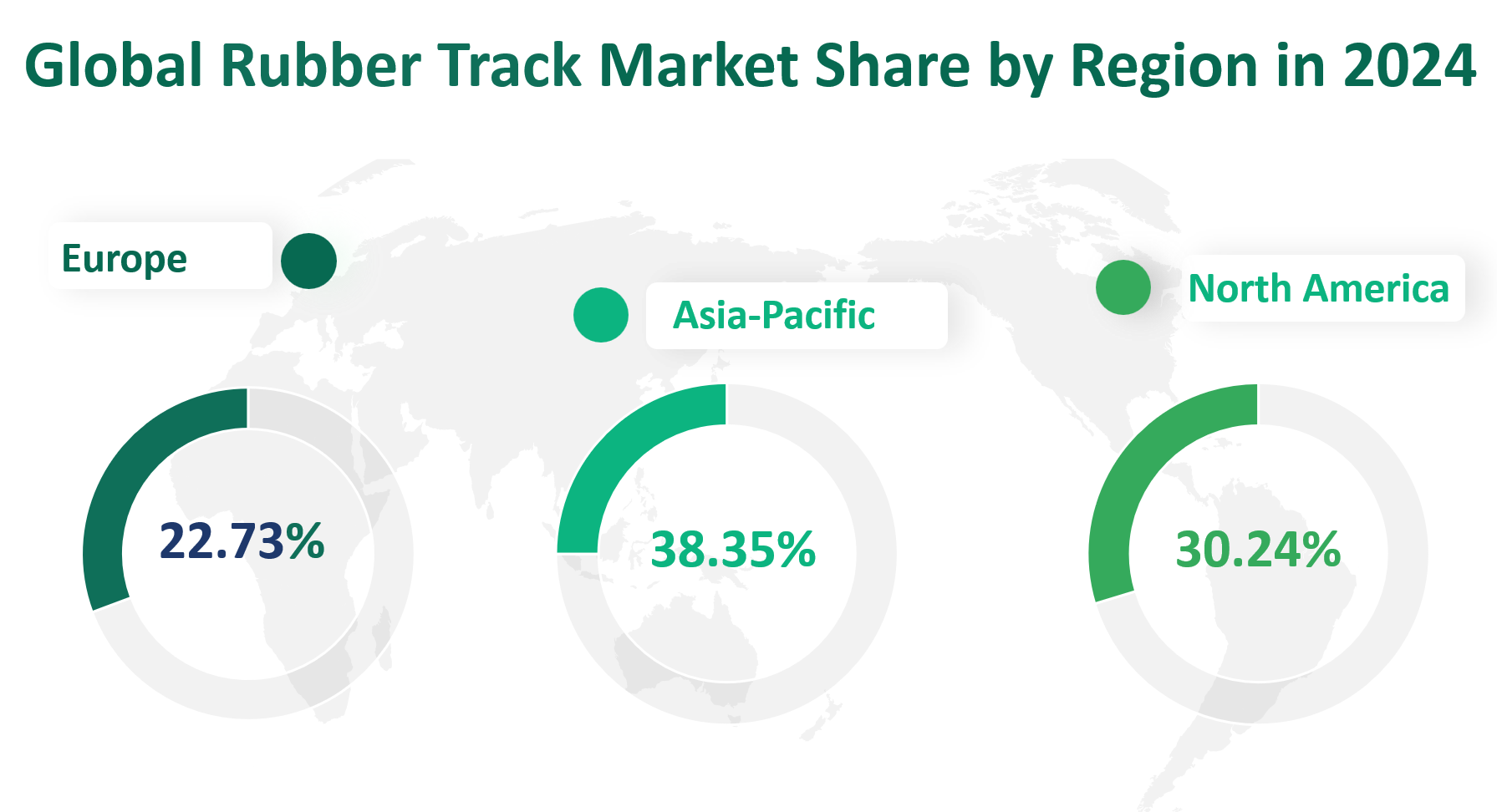1. Global Rubber Track Market Insight Analysis
In 2024, the global Rubber Track market value is projected to reach approximately USD 1,993.51 million, with a Compound Annual Growth Rate (CAGR) of 6.09% forecasted from 2024 to 2033.
Rubber tracks are specialized components made primarily from rubber and manufactured through advanced processes. They are widely used in various industries, including industrial machinery, agricultural machinery, and military vehicles. These tracks are designed to enhance the traction and mobility of vehicles and machinery, particularly on complex terrains such as gravel, mud, and uneven surfaces.
The primary function of rubber tracks is to improve the overall efficiency and performance of heavy machinery by reducing ground pressure and minimizing soil compaction. This makes them particularly suitable for applications in construction, agriculture, and defense sectors. The versatility and durability of rubber tracks have positioned them as a crucial component in modern industrial and agricultural operations, driving their increasing demand globally.
Figure Global Rubber Track Market Size (M USD) and CAGR (2024-2033)

2. Driving and Limiting Factors of Rubber Track Market Growth
The growth of the global Rubber Track market is influenced by a combination of driving and limiting factors. On the positive side, the rapid development of downstream industries, such as construction, agriculture, and mining, has significantly fueled the demand for rubber tracks. The continuous urbanization in emerging economies has led to increased investment in infrastructure projects, which in turn has driven the need for heavy machinery equipped with rubber tracks. Additionally, advancements in manufacturing technologies have enabled the production of more durable and efficient rubber tracks, further enhancing their market appeal.
However, the market also faces several challenges. One of the primary limiting factors is the relatively shorter lifespan of rubber tracks compared to metal tracks. Rubber materials are prone to wear, tear, and aging, especially under harsh operating conditions, which necessitates frequent replacements and increases maintenance costs.
Moreover, the rubber track industry is highly competitive, with significant barriers to entry due to stringent quality standards and the need for advanced technological capabilities. The high cost of raw materials and labor, combined with the impact of inflation, also poses challenges to manufacturers’ profitability. Additionally, regional regulatory requirements and environmental concerns add complexity to the market dynamics.
3. Technology Innovation in Rubber Track Market
Technological innovation plays a crucial role in the Rubber Track market. Manufacturers are increasingly adopting advanced materials and production processes to enhance the durability, performance, and environmental sustainability of rubber tracks. The integration of artificial intelligence (AI) and the Internet of Things (IoT) has enabled real-time monitoring and predictive maintenance of rubber tracks, thereby improving operational efficiency and reducing downtime. Furthermore, companies are focusing on developing lighter and more fuel-efficient tracks to meet the growing demand for sustainable solutions.
4. Global Rubber Track Market Size by Type
The main types of rubber tracks include Staggered Block Tread, C-lug Tread, Normal Bar Tread, Multi-bar Tread, Zig Zag Track, and Others.
Staggered Block Tread is designed for optimal performance on abrasive and hard surfaces such as gravel and paved highways. This type of rubber track is known for its durability and ability to withstand frequent operation on hot roads, making it ideal for heavy machinery used in construction and mining. In 2024, the market value of Staggered Block Tread reached USD 572.75 million, accounting for 28.73% of the total market value. Its robust design and high performance in challenging environments have solidified its position as one of the leading types in the rubber track market.
C-lug Tread is characterized by its unique “C” shaped lug pattern, which provides superior traction and flexibility across different terrains. This type is particularly popular in agricultural and industrial applications where both on-road and off-road performance is required. In 2024, the market value of C-lug Tread was USD 461.31 million, representing 23.14% of the total market value.
Normal Bar Tread is the most common type of rubber track, suitable for a wide range of operating environments, including finished turf, clay, asphalt, sand, and even mud. Its versatility and adaptability to various terrains have made it a popular choice in the market. In 2024, the market value of Normal Bar Tread was USD 291.28 million, accounting for 14.61% of the total market value.
Multi-bar Tread is designed for machinery that frequently moves between hard surfaces and loose ground cover. It offers a balance between traction and smooth ride, making it suitable for both industrial and agricultural applications. In 2024, the market value of Multi-bar Tread was USD 220.79 million, representing 11.08% of the total market value. Its ability to adapt to changing terrains has positioned it as a reliable choice for machinery operating in mixed environments.
Zig Zag Track is specifically designed to maximize traction on muddy or wet terrain, making it ideal for compact loaders and agricultural machinery operating in challenging conditions. In 2024, the market value of Zig Zag Track was USD 281.31 million, accounting for 14.11% of the total market value.
Table Global Rubber Track Market Size by Type in 2024
Market Size (M USD) 2024 | Market Share | |
Staggered Block Tread | 572.75 | 28.73% |
C-lug Tread | 461.31 | 23.14% |
Normal Bar Tread | 291.28 | 14.61% |
Multi-bar Tread | 220.79 | 11.08% |
Zig Zag Track | 281.31 | 14.11% |
Others | 166.07 | 8.33% |
5. Global Rubber Track Market Size by Application
The rubber track market is also segmented based on its applications, which include Industry Machinery, Agricultural Machinery, Military Machinery, and Others.
Industry Machinery is the largest application area for rubber tracks, encompassing heavy equipment such as excavators, bulldozers, and loaders. These machines rely on rubber tracks for their ability to navigate challenging terrains and provide stable operation during construction projects. In 2024, the market value of rubber tracks used in Industry Machinery was USD 1135.85 million, accounting for 56.98% of the total market value.
Agricultural Machinery is another significant application area for rubber tracks, used in tractors, combine harvesters, and other farming equipment. Rubber tracks enhance the mobility and efficiency of agricultural machinery, allowing for better performance on uneven and muddy terrains. In 2024, the market value of rubber tracks used in Agricultural Machinery was USD 571.48 million, representing 28.67% of the total market value.
Military Machinery utilizes rubber tracks in tanks, armored vehicles, and other defense equipment to improve mobility and operational efficiency in various terrains. Rubber tracks offer superior traction and reduced ground pressure, making them ideal for military applications. In 2024, the market value of rubber tracks used in Military Machinery was USD 205.13 million, accounting for 10.29% of the total market value.
Table Global Rubber Track Market Size by Application in 2024
Application | Market Size (M USD) 2024 | Market Share |
Industry Machinery | 1135.85 | 56.98% |
Agricultural Machinery | 571.48 | 28.67% |
Military Machinery | 205.13 | 10.29% |
Others | 81.05 | 4.07% |
6. Global Rubber Track Market by Top Regions
The Asia Pacific region is projected to hold the largest share of the global Rubber Track market in 2024, with a market value of USD 764.47 million. This region’s dominance can be attributed to several key factors. Firstly, countries like China and India are experiencing rapid industrialization and urbanization, leading to increased investment in infrastructure and agricultural development. This has created a substantial demand for rubber tracks used in construction and agricultural machinery.
North America is another significant region in the Rubber Track market, with a projected value of USD 602.92 million in 2024. Companies in this region focus on innovation and product differentiation to maintain their competitive edge. The presence of major players such as Bridgestone and Michelin (Camso) further consolidates the region’s position in the global market.
Europe’s Rubber Track market is expected to reach USD 453.03 million in 2024. The region’s market is driven by its diverse industrial base, which includes construction, agriculture, and defense. European companies are known for their high-quality products and advanced manufacturing technologies.
South America and the Middle East & Africa are emerging regions in the Rubber Track market, with projected values of USD 117.38 million and USD 55.71 million, respectively, in 2024.
Figure Global Rubber Track Market Size by Region in 2024

7. Global Rubber Track Market Analysis by Major Players
7.1 Bridgestone
Introduction and Business Overview: Bridgestone, founded in 1931 and headquartered in Japan, is a global leader in the production of tires and rubber products. The company operates through segments such as Tires and Diversified Products, offering a wide range of products including rubber tracks for various applications.
Products Offered: Bridgestone specializes in manufacturing rubber tracks for mini excavators, compact track loaders, and other heavy machinery. Their products are known for their durability and high performance, making them suitable for challenging terrains.
Sales Revenue in 2024: Bridgestone’s rubber track sales revenue in 2024 is projected to be USD 456.42 million, reflecting its strong market position and continuous innovation.
7.2 Michelin (Camso)
Introduction and Business Overview: Michelin (Camso), established in 1982 and headquartered in Canada, is a leading manufacturer of off-road tires, wheels, and rubber tracks. The company focuses on providing high-performance products for material handling, construction, agriculture, and powersports industries.
Products Offered: Michelin (Camso) offers a variety of rubber tracks with advanced tread patterns and materials designed to maximize traction and durability. Their products are used in various applications, including compact track loaders and agricultural machinery.
Sales Revenue in 2024: Michelin (Camso)’s rubber track sales revenue in 2024 is expected to reach USD 240.71 million, highlighting its strong presence in the global market.
7.3 Zhejiang Yuan Chuang Rubber Track
Introduction and Business Overview: Founded in 1991 and headquartered in China, Zhejiang Yuan Chuang Rubber Track is a major manufacturer of rubber conveying products. The company specializes in producing rubber tracks, track shoes, and other rubber products for industrial and agricultural machinery.
Products Offered: Zhejiang Yuan Chuang Rubber Track offers a range of rubber tracks, including engineering and agricultural rubber tracks. Their products are known for their shock absorption, noise reduction, and durability, making them suitable for various applications.
Sales Revenue in 2024: The company’s rubber track sales revenue in 2024 is projected to be USD 174.92 million, reflecting its growing market share and expanding product portfolio.

